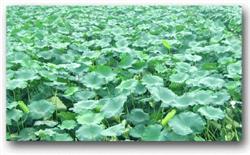Prevention and control of lotus root rot should be timely.

Q: the lotus root planted in my family grew very well at the beginning, but now the leaves have dried up and several drugs have not worked. What on earth is going on? What medicine can be used to cure it? at present, the leaf disease of lotus root is mainly lotus root rot disease, which is the first major disease in lotus root production, mainly harming the underground stem and upper leaves. Most of the germs invaded from the wound, absorbing root or growing point. The leaves of diseased stems are light green in color and brown and dry from the leaf margin until the petiole finally dies and the underground stem is rotten. Generally speaking, the disease is easy to occur in the old lotus root field and continuous cropping field in the tillage layer and shallow water, and the pathogen spreads with running water irrigation, and the onset time is mostly from July to September. Comprehensive control method: crop rotation and stubble. The same field was planted for two years at most, and the rotation of flood and drought was adopted to reduce the amount of bacteria in the soil. Disease-free lotus root and seed lotus root were selected for disinfection. The bacteria carried by lotus root is the main source of rot disease. Before planting lotus root, soak the lotus root with more than 60% carbendazim or wettable methyl topiramate 800 times solution, or 75% chlorothalonil 800 times solution, soak out and dry for 30 minutes before sowing. Removal of diseased plants and soil treatment of lotus root field. Thoroughly remove the diseased plants and remnants of the diseased lotus root field, and bury them deeply or burn them centrally. Applying lime nitrogen 50~100kg per mu or disinfecting lotus root soil with 55% dimethazone 1kg before planting (more than a week) can not only sterilize and clean the countryside, but also accelerate the decomposition of organic fertilizer. adequate manuring. The base fertilizer should be based on organic fertilizer, and the fertilizer must be fully mature. In the soil with heavy acidity and strong reducibility. During the growth period, attention should be paid to the combined application of nitrogen, phosphorus and potassium fertilizer, siliceous fertilizer should be added where possible, boron, zinc, molybdenum and other micro-fertilizers should be advocated, and chemical nitrogen fertilizer should not be applied to improve plant disease resistance. Timely use of medicine for prevention and treatment. At the initial stage of the disease, use 70% methyl topiramate wettable powder 800 × 1000 times, or spray with more than 60% carbendazim wettable powder plus 75% chlorothalonil 600 × 800 times. Spraying foliar or petiole for 2 or 3 times can effectively reduce or control the spread of the disease.
- Prev

Prevention is the key to the rot of lotus root.
Rot disease is a common disease on lotus root, which occurs to varying degrees every year. The planting area of lotus root in Wuhan is large, and the local lotus root rot occurs seriously. Lotus root species in most areas are introduced from Wuhan, so the disease of lotus root field rot has occurred seriously in some areas in recent years. The vascular bundles of the plant will turn brown after the disease.
- Next

Technical methods of seed selection and retention of Lotus Root
(1) selection and breeding. The selection and breeding of lotus root mainly includes asexual seed selection and sexual cross breeding. 1. Asexual selection. China is rich in lotus root germplasm resources, which provides good conditions for asexual selection. In recent years, varieties selected from superior clones include Kexuan 1, Elian 1 and Zhejiang Lake.
Related
- Where is it suitable to grow horseradish in China? it is expected to see the middle altitude horseradish in Alishan.
- How to prevent tomato virus disease reasonably? (Control methods included)
- Many people like to plant towel gourd on the balcony. What are the main points of this method and management?
- What crops can chili peppers be mixed with?
- Fertilization techniques and matters needing attention in Tomato
- What are the grafting techniques for peach seedlings in spring?
- Harm and control methods of root swelling disease of Chinese cabbage
- What are the pests of sweet potatoes? How to prevent and cure it?
- Symptoms, causes and Control methods of navel Rot in Tomato
- The cause of "Cucumber rotten bibcock" in Farmers' planting Cucumber and its Control Plan

